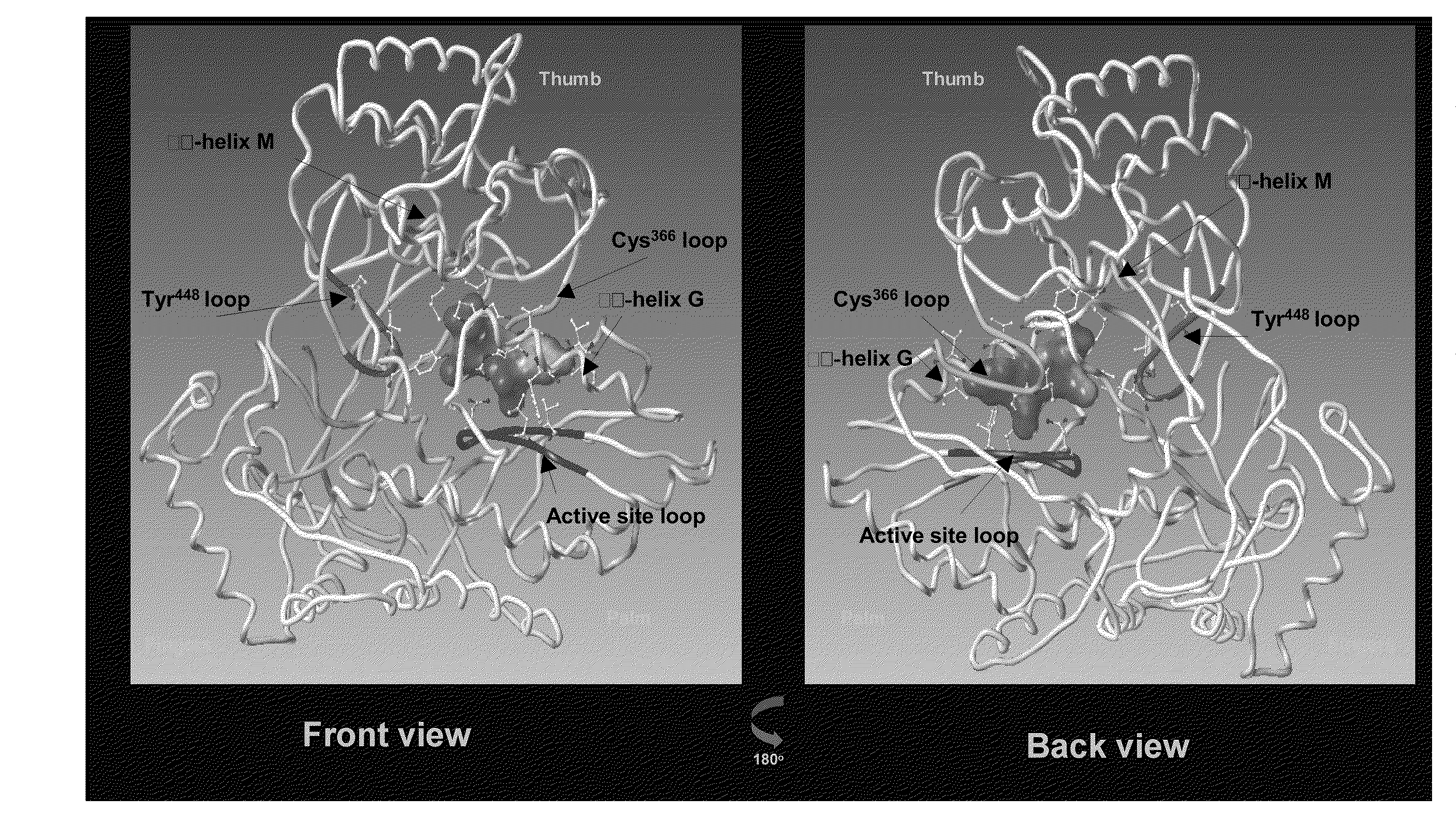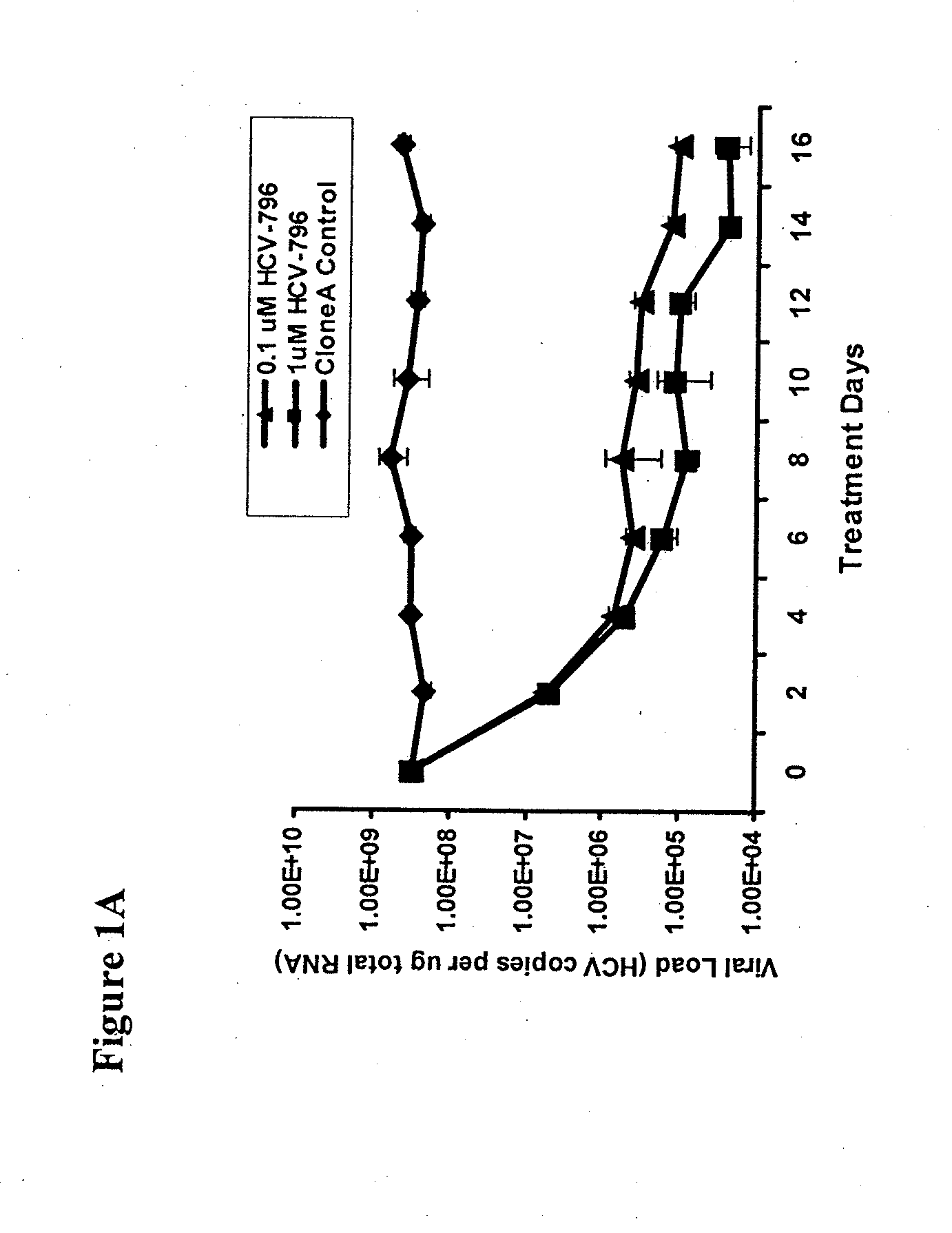Identification and characterization of hcv replicon variants with reduced susceptibility to benzofurans, and methods related thereto
a technology of benzofuran and hcv, which is applied in the field of ns5 inhibitors of hepatitis c virus, can solve the problems of rapid generation of drug-resistant virions, emergence of treatment-resistant hepatitis c viral infections, and decrease of so as to reduce sensitivity to ns5b polymerase inhibitors and high viral replication rates. , the effect o
- Summary
- Abstract
- Description
- Claims
- Application Information
AI Technical Summary
Benefits of technology
Problems solved by technology
Method used
Image
Examples
example 1.1
Materials
[0134]All tissue culture reagents were purchased from Gibco / BRL® (Invitrogen, Carlsbad, Calif.) and Hyclone (Hyclone, Logan, Utah). Clone A cells (licensed from APATH, LLC, St. Louis, Mo.) were derived from Huh-7 cells, a human hepatoma cell line. The Clone A cells contain approximately 500 to 1000 genome copies of HCV genotype 1b replicon per cell when maintained in a subconfluent monolayer in the presence of 1 mg / ml G418. The sequence of the replicon in the Clone A cells is similar to that of the genotype 1b Con 1 strain of HCV (GENBANK® accession no. AJ238799) with the exception of two mutations at NS3 (Q1112R) and NS5A (S2204I). Clone A cells were propagated in Dulbecco's minimal essential medium (DMEM; Gibco / BRL) containing 10% fetal calf serum (FCS; Hyclone) supplemented with 1% penicillin / streptomycin (GibcoBRL), 1% nonessential amino acids (Gibco / BRL), 1 mg / ml Geneticin™ (G418 sulfate; GibcoBRL) and 0.66 mM HEPES buffer, pH 7.5.
[0135]The plasmid pBB7, containing the...
example 1.2
Cell Culture
[0136]Approximately 3×105 Clone A cells were seeded in a T-25 tissue culture flask in triplicate and cultured in medium containing 2% FCS without G418 and 0.1 or 1 μM HCV-796 dissolved in dimethyl sulfoxide (DMSO, final concentration in the medium was 0.5%, v / v). As a control, Clone A cells were passaged in parallel in the same medium containing 0.5% DMSO without compound. When the cell density reached approximately 80% confluence (about 2-3 days), the cells were split 1:3 in fresh medium containing HCV-796. An aliquot of the cells from each passage was collected to monitor the HCV RNA levels.
[0137]As the intracellular HCV viral load reduced and reached a plateau (about 16 days), fresh medium containing HCV-796 and 0.5 mg / ml G418 was added to select for cells containing the replicon variants. Approximately 20 days after the selection, small colonies of cells resistant to the inhibitor and the antibiotic became visible and were pooled. The resistant cells (796R) generated...
example 1
Results
[0139]To select for HCV-796-associated replicon variants, cells bearing a genotype 1b HCV replicon were treated multiple times with 0.1 and 1 μM HCV-796 (an equivalent of 10- and 100-fold EC50, respectively, for HCV-796 in a 3-day assay). At the end of the 16-day treatment, about 3.6-log10 and 4.2-log10 decreases in the HCV RNA levels were observed in the cells treated with 0.1 and 1 mM HCV-796, respectively (FIG. 1A). The level of a housekeeping gene, GAPDH mRNA, remained essentially unchanged throughout the 16-day period (FIG. 1B). These results suggested that HCV-796 has a direct antiviral effect on HCV replication, and that the compound is well tolerated by the cells.
[0140]The HCV replicon encodes a drug-selectable gene (neomycin phosphotransferase) that allows for selection of a functional replicon in the presence of G418. During the course of drug selection, only cells that contain replicon variants with reduced susceptibility to HCV-796 survived and gave rise to coloni...
PUM
| Property | Measurement | Unit |
|---|---|---|
| weight | aaaaa | aaaaa |
| concentrations | aaaaa | aaaaa |
| volume | aaaaa | aaaaa |
Abstract
Description
Claims
Application Information
 Login to View More
Login to View More - R&D
- Intellectual Property
- Life Sciences
- Materials
- Tech Scout
- Unparalleled Data Quality
- Higher Quality Content
- 60% Fewer Hallucinations
Browse by: Latest US Patents, China's latest patents, Technical Efficacy Thesaurus, Application Domain, Technology Topic, Popular Technical Reports.
© 2025 PatSnap. All rights reserved.Legal|Privacy policy|Modern Slavery Act Transparency Statement|Sitemap|About US| Contact US: help@patsnap.com



